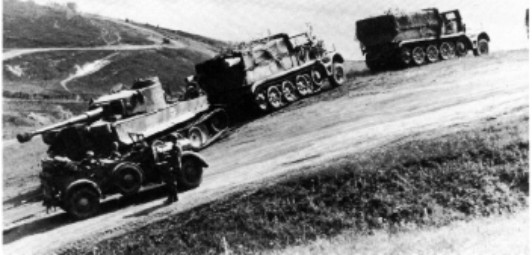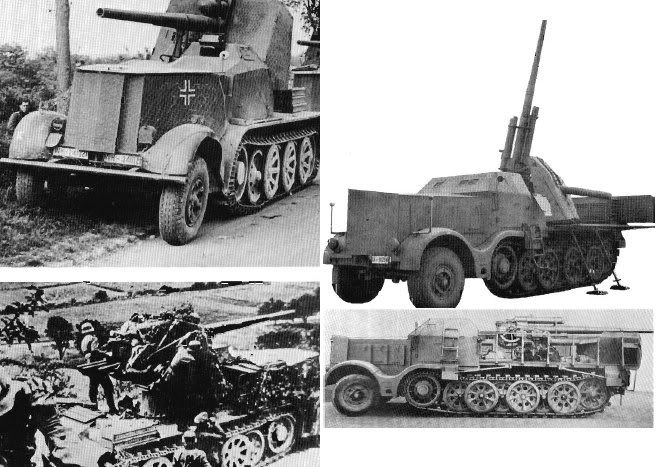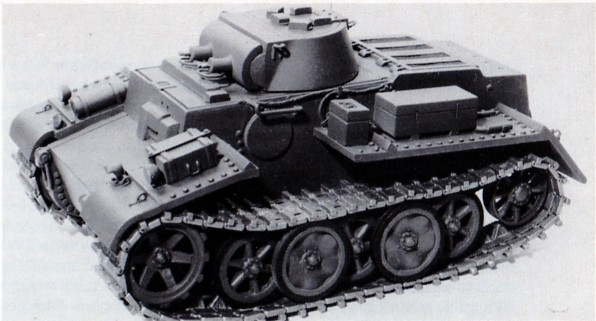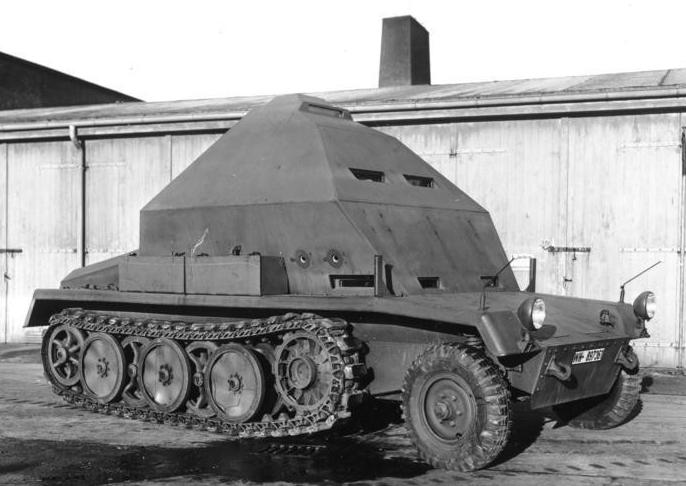thanks for the pics,very interesting. do you have any on the sturm emil?
Sure I do, check the "panzer Projekte " topic.

thanks for the pics,very interesting. do you have any on the sturm emil?
Sure I do, check the "panzer Projekte " topic.
SD.Kfz 9.
The Heer heavy tractor for towing the biggest vehicles and guns.
An interesting view of 3 FAMOs towing a 38 cm gun barrel for Batterie Todt near Calais

This Pz. Kpfw. III Ausf. E or F has probably slipped off the road, and is about to be saved by an Sd. Kfz. 9 “Famo”. This vehicle too has a lot of supplies on its rear deck

Sd.Kfz 9 of the Afrika Korps.

Specifications for Type SD.Kfz 9 F3:
Type: Heavy Half-Tracked Prime Mover
Production Period: 1939 to 1944
Producers: FAMO, Vomag and Tatra
Number Produced: approx. 2500 (all types)
Gross Weight: 18000kg
Empty Weight (with fuel and equipment): 12130kg
Cargo Load (8 men and 1900kg cargo): 2870kg
Total Length: 8.25m
Total Width: 2.60m
Total Height: 2.85m / 2.77m without canvas cover & windscreen
Engine: Maybach HL 108 TUKRM / 230hp / 12-cylinder
Tracks: Zgw. 50/400/200 / 440mm wide / 47 links per side
Maximum Road Speed: 50km/h
Range: 250km
Towed Load (weight) Normal: 18000kg
Fuel Capacity: 290l

Hmmmm, maybe the Maybach engine should have been installed in the Tiger, would’nt need a tow then…
Hahaha, would nave needed wings then. :roll: 
I dont know if this photo is faked but 2 Sd.kfz 9 pulling a Tiger in a climb sounds too much.

Crane for panzer repair variant.
Two Sd. Kfz. 9 were common to pull a Tiger but, right, with an acclivity? Maybe that Horch has to push a bit!
In the right upper corner, maybe it’s a third Sd.kfz 9.
Here an other photo:

Yes, Is visible now, 2 seemed too little. 
8.8cm Flak 37 Selbstfahrlafette Auf Zugkraftwagen 18t
[LEFT]An armored variant of the SD.Kfz 9 made in response to a requeriment for a heavy self mobile support gun. A 8,8 cm centimeters Flak gun was emplaced behind and armored driver cabin.

The gun was designed to engage field fortification and bunkers, it was used against tanks as makeshift tank destroyer despite the fact its mounting was too high and not really suitable for the task.
About 50 were made betwenn 1939 and 1942 and used in Poland, France and Russia.[/LEFT]
Sd.Kfz 252.
Ammunition carrier based on the Sd.Kfz 10 1 ton halftrack and with the 8 mm body of the recce/ observation Sd.kfz 253 . Used mostly for suppling the Stug III batallions.


The Sd.Kfz 252 were equipped with an sonder-anhänger 32 ( specialized trailed) to carry aditional 32 rounds of 75 mm “short” ammo.
Maximum speed on road was 62 km/h and the range 200 km.
413 Sd.kfz 252 were completed between 1939-41.

Sd.Kfz 301 “Borgward”
In October 1941, Borgward was order to develop the B III VK 302 to a schwere ladungsträger - B IV Sd. Kfz. 301 and, from the experiences with the B I and B II, a leichter ladungstraeger Goliath Sd. Kfz. 302.
Known as the B IV, it was designated by the Waffenamt as Sprengladungsträger ( explosive charge carrier) (Sd. Kfz. 301).

The Sd. Kfz. 301 Borgward IV measured 3.65m in length, 1.8m in width and 1.19m in height. It weighed 3.6 tons and used the same engine as VK 302, giving it a maximum speed of 38km/h. It had a one-man crew, who drove the vehicle to the launch spot before engaging the enemy. Thereafter the 8mm protection plates around the driver was folded down to protect the radio and then the vehicle was radio-controlled towards the target. When engaging the enemy, a 500kg explosive charge carried on the frontal armor plate was offloaded.
The vehicle backed away and the explosive charge was set off with delayed detonation. Some 12 experimental vehicles were built in April 1942. Series production began in May 1942 and approximately 616 Borgward IV Ausf. A were built until June 1943, the Ausf. B being built in 260 examples until November 1943 and some 305 Ausf. C were built from December 1943 to September 1944.

The Ausf. B only differed a little from the Ausf. A, it weighed 400kg more, the radio antennae was moved and the radio-equipment had been improved. Borgward IV Ausf. C weighed 4.85tons, measured 4.1m in length, 1.83m in width and 1.25m in height. It carried thicker armor and used new tracks. The drivers position were moved from right to the left side. It also used a more powerful Borgward engine, providing some 78hp.
I put on my bi-focals, and there seems to be tow cables between the halftracks, so they were ganged together. That would be much enough to pull the Tiger.
More importantly the officer standing beside the staff car is standing on a lean towards the incline which indicates there is nothing faked about this picture.
Panzer I, n. A., VK 1801.
Welded with 80mm plates. Originally developed in late 1939 for the intended storm on the Maginot Line, built by Krauß-Maffei and MAN.

Hi.
The two vehicles on the left are SdKfz 8, not SdKfz 9…
By the way, some of these vehicles were used post-war by the czechoslovakian army.
Yours
tom! 
Thank you for the amendment.
Panzer II ausf L “Luchs”

In late 1941 the HeeresWaffeAmt (HWA) ordered the design of a new 13 tons fast fully tracked vehicle for recoinassance purposes.
It was to be armed with a 37 or 20 mm gun and a machinegun, it should had a powerful radio set in order to comunicate with platoon commanders and artillery batteries up to 35 km.
3 proposal were submitted in june 1942, one from Skoda, other form MAN, and the later by Saurer.
After intensive testing the Man proposal was declared as the winner in june 1942, eventually 300 vehicle were ordered but later this order was reduced to 100 tanks.

Characteristics panzerkampfwagen II ausf L
Type: Recce tank
Crew: 4
Weight in combat : 13250 kg
Armor: 30mm front hull and turret, 20 mm sides, 12mm top deck and roof.
Engine: 6 cilinders Maybach HL 66 water cooled, 200 hp
Speed on road: 60 km/h
Off road: 30 km/h
Armament: 1 Kwk 38 fully automatic 20 mm gun with 330 rounds, plus a MG 42 with 3350 rounds of S.m.K ammunition.
Turret operation: manual
Internal view of the turret viewing from the commander seat, the MG 42 is removed.

The lynx included some extras like the heating and extra ventilation for the crew, also it had 2 devices for starting the engine is severe cold conditions. 31 were delivered by the 1th january 1943, after the 100th vehicle was manufatured in july 1943 all the program was cancelled, the tank did not fullfill completely the needs of the Heer, mostly because their size. its planned sussesor, the VK 1601 “Leopard” did not manage to enter in service.

Just for the unique looks of it - another one of the Feuerleitpanzer taken at Heer test site, Peenemünde in 1942 (see post #9 for details to this vehicle):
